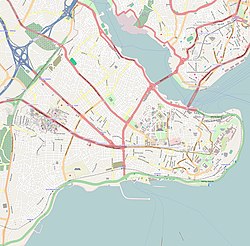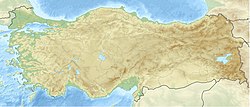Top Qs
Timeline
Chat
Perspective
Basilica Cistern
Ancient cistern beneath Istanbul, Turkey From Wikipedia, the free encyclopedia
Remove ads
The Basilica Cistern, or Cisterna Basilica (Greek: Βασιλική Κινστέρνα, Turkish: Yerebatan Sarnıcı or Yerebatan Sarayı, "Subterranean Cistern" or "Subterranean Palace"), is the largest of several hundred ancient cisterns that lie beneath the city of Istanbul, Turkey. The cistern, located 150 metres (490 ft) southwest of the Hagia Sophia on the historical peninsula of Sarayburnu, was built in the 6th century during the reign of Byzantine emperor Justinian I.[1] Today it is kept with little water, for public access inside the space.
Remove ads
History
Summarize
Perspective
This subterranean cistern was called Basilica because it was located under a large public square, the Stoa Basilica, on the First Hill of Constantinople.[2] Prior to its construction, a great basilica stood on the spot. It had been built during the Early Roman Age between the 3rd and 4th centuries as a commercial, legal and artistic centre.[1] The basilica was reconstructed by Illus after a fire in 476.[citation needed]
Ancient texts indicated that the basilica cistern[3] contained gardens surrounded by a colonnade that faced the Hagia Sophia.[1] According to ancient historians, Emperor Constantine built a structure that was later reconstructed and enlarged by Emperor Justinian after the Nika riots of 532, which devastated the city.[citation needed]
Historical texts claim that 7,000 slaves were involved in the construction of the cistern.[1]
The enlarged cistern provided a water filtration system for the Great Palace of Constantinople and other buildings on the First Hill, and continued to provide water to the Topkapı Palace after the Ottoman conquest in 1453 and into modern times.[citation needed]
The existence of the cistern was eventually forgotten by all but the locals who still drew water from it until, in 1565, the French traveller Petrus Gyllius left a record of it. Gyllius recorded being rowed in between the columns and seeing fish swimming in the water beneath the boat.[4]
Remove ads
Restoration history
Summarize
Perspective
1985–1987 works
The first major modern restoration of the Basilica Cistern was undertaken by the Istanbul Metropolitan Municipality between 1985 and 1987.[5] More than 50,000 tons of silt were removed from the reservoir, uncovering the Medusa-head column bases.[6] Elevated wooden walkways were introduced, allowing the structure to open to the public as a museum in 1987.[7]
2020–2022 restoration
A comprehensive restoration was carried out between 2020 and 2022 by the İBB Miras team.[6] The deteriorated iron tie-rods were replaced with stainless-steel compression rods, anchored with star-shaped plates, to improve seismic resilience.[8]
Concrete walkways and a 50 cm-thick cement render added in the mid-20th century were dismantled. Approximately 1,440 m3 of concrete and 1,600 m3 of sediment were removed, revealing the original 6th-century Byzantine brick floor beneath.[6]
A new modular steel walkway was installed, physically separated from the historic structure, improving structural performance and visitor experience.[6] Conservation treatments included gentle cleaning of marble and brick surfaces to remove biological growth and salt crystallization.[5]
New LED lighting and sensors were also installed to support atmospheric lighting and non-invasive digital exhibitions.[6]
Remove ads
Legal status and conservation framework
The Basilica Cistern is part of the "Historic Areas of Istanbul," a UNESCO World Heritage Site since 1985.[9] Nationally, it is protected under Turkey's Law No. 2863 on the Conservation of Cultural and Natural Property as a 1st-degree archaeological site.[10]
This classification restricts permanent alterations and mandates that all interventions be reversible and approved by the Istanbul No. 1 Cultural Heritage Preservation Board.[10] In 2011, the board ordered the restriction of heavy vehicle traffic near the site to mitigate vibration-related damage.[5]
Adaptive reuse and exhibitions
In 2022, the Basilica Cistern hosted the digital exhibition Daha Derine ("Going Deeper"), curated by İBB Miras.[6] The exhibition featured contemporary artworks by Jennifer Steinkamp, Ozan Ünal, Aslı İrhan, and Ali Abayoğlu, using projection mapping, sculpture, and light to reflect on the site's themes of memory, mythology, and water. [citation needed]
These installations were temporary, non-invasive, and mounted on reversible infrastructure added during the 2020–2022 restoration.[6]
Remove ads
Features
Summarize
Perspective
This cathedral-size[11] cistern is an underground chamber approximately 138 metres (453 ft) by 65 metres (213 ft)[12] – about 9,800 square metres (105,000 sq ft) in area – capable of holding 80,000 cubic metres (2,800,000 cu ft) of water.[2] The ceiling is supported by a forest of 336[13] marble columns, each 9 metres (30 ft) high, arranged in 12 rows of 28 columns each spaced 5 metres (16 ft) apart. The capitals of the columns are mainly in the Ionic and Corinthian style, with the exception of a few Doric capitals with no engravings. One of the columns is carved with raised pictures of a Hen's Eye, slanted branches, and tears, and resembles the columns of the 4th-century Triumphal Arch of Theodosius I (AD 379–395), erected in the 'Forum Tauri' Square, today's Beyazıt Square. The majority of the columns in the cistern appear to have been recycled from the ruins of older buildings (a process called 'spoliation'), likely brought to Constantinople from various parts of the empire, together with those that were used in the construction of Hagia Sophia. They are carved out of different types of marble and granite.[1]
Fifty-two stone steps descend into the cistern which is surrounded by a firebrick wall with a thickness of 4 metres (13 ft) and coated with a waterproofing mortar. The Basilica Cistern's water came from the Eğrikapı Water Distribution Centre in the Belgrade Forest, which lie 19 kilometres (12 mi) north of the city. It traveled via the 971-metre-long (3,186 ft) Valens (Bozdoğan) Aqueduct, and the original 115-metre-long (377 ft) Mağlova Aqueduct, which was built by the Emperor Justinian.[1]
The weight of the cistern is carried on the columns by means of the cross-shaped vaults and round arches of its roof. [citation needed]
The Basilica Cistern has been restored several times since its original creation. The first repairs were carried out in the 18th century during the reign of the Ottoman sultan Ahmed III in 1723 by the architect Muhammad Ağa of Kayseri. The second major repair was completed during the 19th century reign of Sultan Abdulhamid II (1876–1909). Cracks in the masonry and damaged columns were repaired in 1968, with additional restoration in 1985 by the Istanbul Metropolitan Museum. During the 1985 restoration, 50,000 tons of mud were removed from the cistern, and platforms were erected to replace the boats previously used for touring the cistern. The cistern was opened to the public on 9 September 1987. It underwent additional cleaning In May 1994. Then in 2017 it was once again closed for restoration and earthquake-proofing, reopening to the public in 2022.[14]
Remove ads
Medusa column bases

The bases of two columns In the northwest corner of the cistern reuse blocks carved with the face of Medusa.[15] The origin of the two heads is unknown, though it is thought that they were brought to the cistern after being removed from a building of the late Roman period. There is no evidence to suggest that they were previously used as column bases. Tradition has it that the blocks are oriented sideways and inverted in order to negate the power of the Gorgons' gaze.[16]
Remove ads
In popular culture
Summarize
Perspective
The cistern was used as a location for the 1963 James Bond film From Russia with Love.[17] In the film, it is referred to as having been constructed by the Emperor Constantine, with no reference to Justinian, and is fictitiously located under the Soviet consulate. In reality it is a long way away from the former Soviet (now Russian) consulate in Beyoğlu. [citation needed]
The cistern plays a key role in Dorothy Dunnett's historical novel Pawn in Frankincense (1969), fourth volume of The Lymond Chronicles.[citation needed]
In the fantasy series The Old Kingdom, the reservoir beneath the palace in Belisaere was inspired by the cistern.[18]
The finale of the 2009 film The International takes place in a fantasy amalgam of the Old City, depicting the Basilica Cistern as lying beneath the Sultan Ahmed Mosque, which, in the film, is directly adjacent to the Süleymaniye Mosque.[citation needed]
In the 2011 video game, Assassin's Creed: Revelations, the player-controlled character, Ezio Auditore, is given the chance to explore a section of this cistern in a memory sequence entitled The Yerebatan Cistern.[19][20]
The cistern also features in Jean-Baptiste Andrea's film thriller Brotherhood of Tears (2013). In the sequence, the lead character, acting as a transporter (played by Jeremie Renier), delivers a suitcase to a mysterious client (played by Turkish actor Ali Pinar). [citation needed]
The cistern with its inverted Medusa pillar featured in the 2013 Dan Brown novel Inferno[21] (as well as its 2016 film adaptation).[22]
The cistern is featured in Age of Empires IV as one of the two Castle Age Landmarks of the Byzantines, named Cistern of the First Hill.[citation needed]
Remove ads
Gallery
- Statues in Basilica Cistern
- Art installation inside Basilica Cistern
- Columns and vaults of Basilica Cistern
- Medusa head
- Atmospheric lighting now brightens up a visit to the Basilica Cistern
- Unique "peacock-eyed" column in the Basilica Cistern
- Cisterna Basilica is located to the west of Hagia Sophia and is of a similar size. The square on the left of the map marks the location of the Cistern of Philoxenos.
Remove ads
See also
- Cistern of Philoxenos (Istanbul)
- History of Roman and Byzantine domes
- List of Roman cisterns
- Theodosius Cistern (Istanbul)
References
Bibliography
Further reading
External links
Wikiwand - on
Seamless Wikipedia browsing. On steroids.
Remove ads











